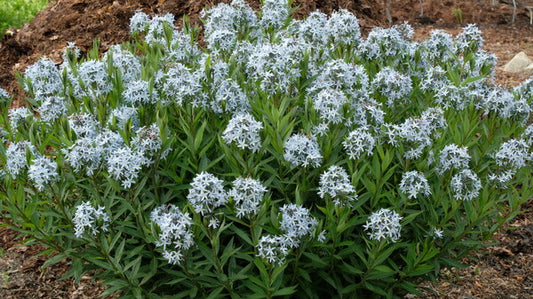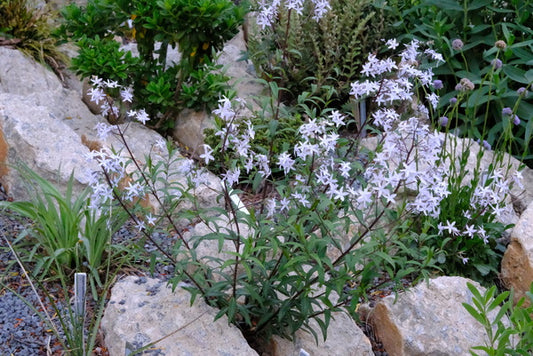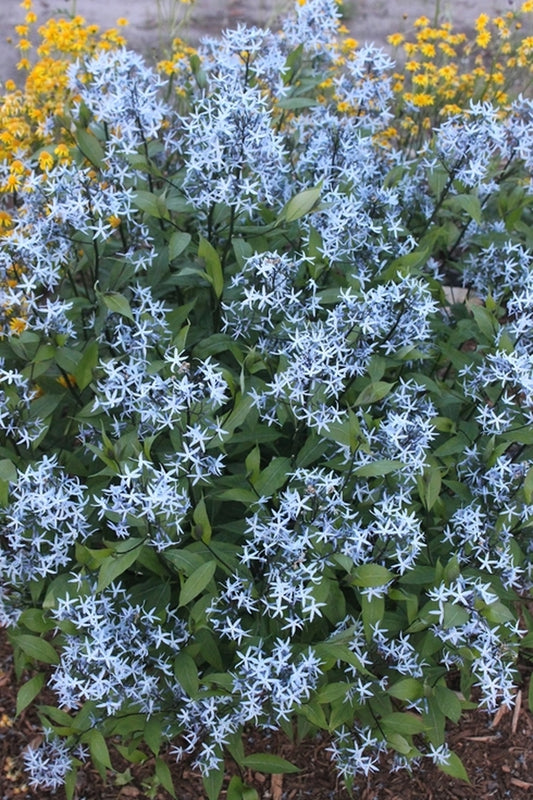Amsonia (Blue Star) are a group of mostly native deer-resistant perennials prized both because they make such good drought-tolerant plants and because they bear one of the few true blue flowers of any growable perennial. Not only are the species themselves superb, but many of the newer hybrids are going to become garden staples.
-
Amsonia glaberrima 'Hardin's Gem'
Item #: 16876
Zones: 5a to 8b, guessing
Dormancy: Winter
Height: 30" tall
Culture: Sun to Part Sun
Origin: United States
Pot Size: 3.5" pot (24 fl. oz/0.7 L)
Regular price $24.00Regular priceUnit price per -
Amsonia hubrichtii
Item #: 759
Zones: 5a to 9b
Dormancy: Winter
Height: 36" tall
Culture: Sun
Origin: United States
Pot Size: 3.5" pot (24 fl. oz/0.7 L)
Regular price $22.00Regular priceUnit price per -
Amsonia rigida 'Black's Dwarf'
Item #: 17144
Zones: 6a to 9b
Dormancy: Winter
Height: 15" tall
Culture: Sun to Part Sun
Origin: United States
Pot Size: 3.5" pot (24 fl. oz/0.7 L)
Regular price $26.00Regular priceUnit price per -
Amsonia tabernaemontana 'Storm Cloud'
Item #: 12043
Zones: 5a to 8b, at least
Dormancy: Winter
Height: 24" tall
Culture: Sun to Part Sun
Origin: United States
Pot Size: 3.5" pot (24 fl. oz/0.7 L)
Regular price $22.00Regular priceUnit price per
More Information About Amsonia
Amsonia (Blue Star) is a genus of mostly native plants. These perennial wildflowers attract butterflies, and are deer-resistant, sun-loving plants prized for their drought tolerance and true blue flowers. Not only are Amsonia species themselves superb, but many of the newer amsonia (blue star) hybrids could become garden staples. Amsonia hubrichtii was named the 2011 Perennial Plant of the Year by the Perennial Plant Association for its delicate texture, blue flowers and fantastic yellow fall foliage. Amsonia hubrichtii has long been one of our favorites too.
Amsonia is a tough, easy to grow, deer-resistant, full sun perennial that tolerates a variety of garden soils. Amsonia looks great grown in a large drift but also makes a wonderful backdrop or companion plant for other garden species. When you are ready to buy amsonia for your garden, check out our list of Amsonia Blue star for sale.
Try creating an astronomy garden that contains Amsonia (Blue Star) plus golden star (Chrysogonum), blazing star (Liatris), white star grass (Dichromena), star flower (Ipheion), star of persia (Allium), blue star creeper (Laurentia), Zephyranthes 'Morning Star', Crinum 'Stars and Stripes', Yucca 'Tiny Star' and Kniphofia 'Sally's Comet'. This constellation of color will have you seeing stars all year long.
Maintenance:
Amsonia is a low maintenance perennial that improves over time and doesn't require division or resetting. It is resistant to deer browsing. However, it can hybridize with other amsonias in the garden, leading to seeds that don't produce true offspring. To prevent this, we recommend discarding the long, thin, brown pods before they drop seeds in mid to late summer.
While the ornamental value of bluestar foliage diminishes when it turns brown, gardeners can choose to either cut the stems down to the ground for tidiness or leave them throughout winter without negative effects. For optimal growth, it's advised to trim the stems before new spring growth begins.
Growing Conditions:
Amsonia is versatile in most garden conditions, thriving in both dry soils near cacti and damp, pondside soils. While it can tolerate some light shade, it achieves its best performance and flowering with over 4 hours of daily sunlight.
Garden Value:
Every Amsonia species offers value through its early blooming of vivid blue flowers and its slender foliage, which creates an appealing contrast to more robust textured plants.
Natural Impact:
Blue star flowers are pollinated by a diverse range of insects such as butterflies, moths, long-tongued bees, and hummingbirds.






